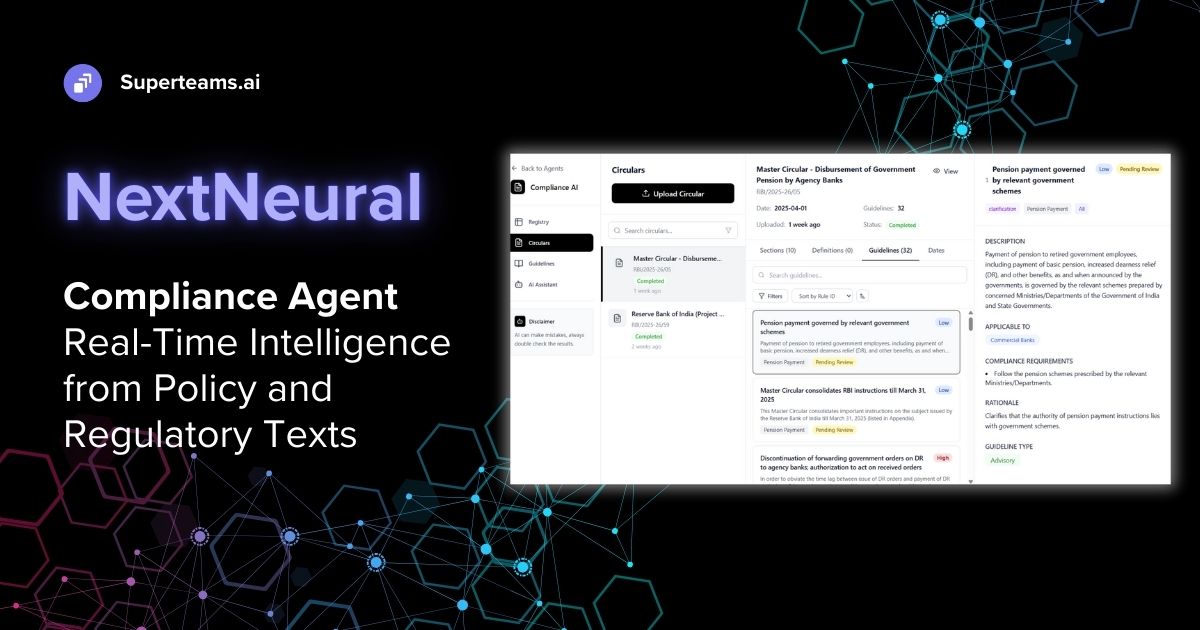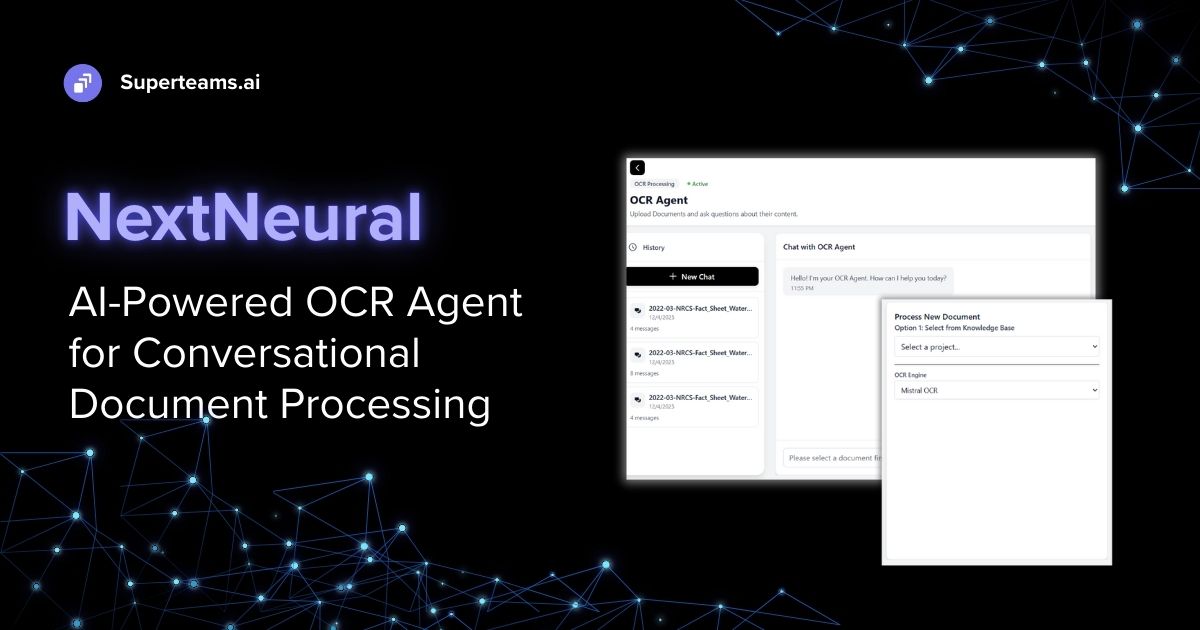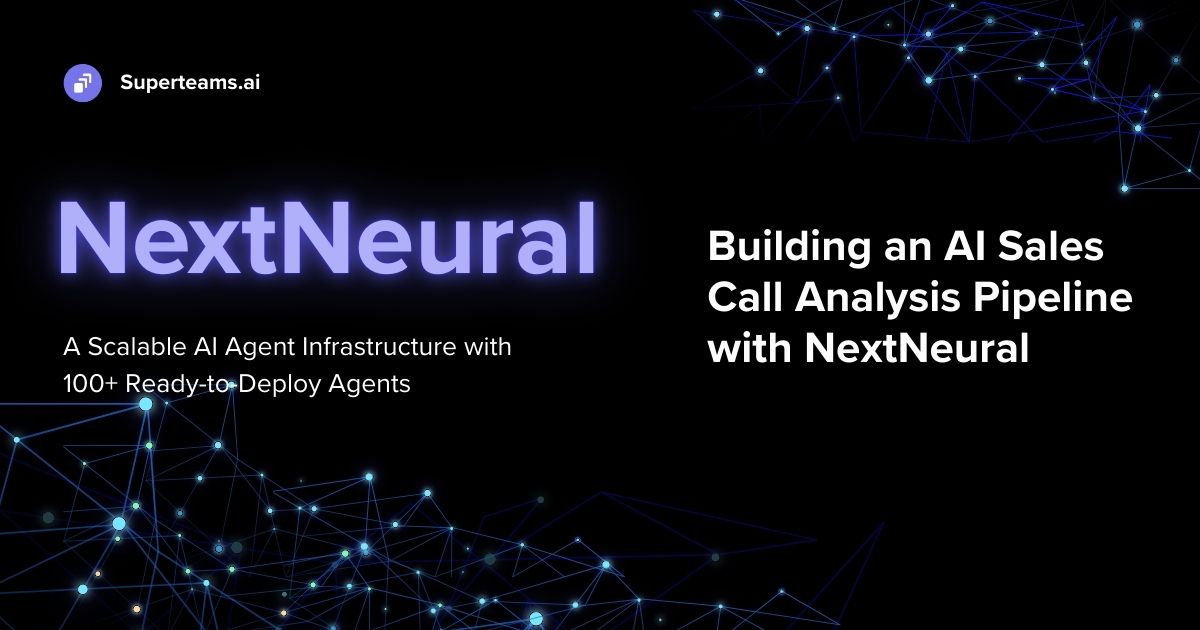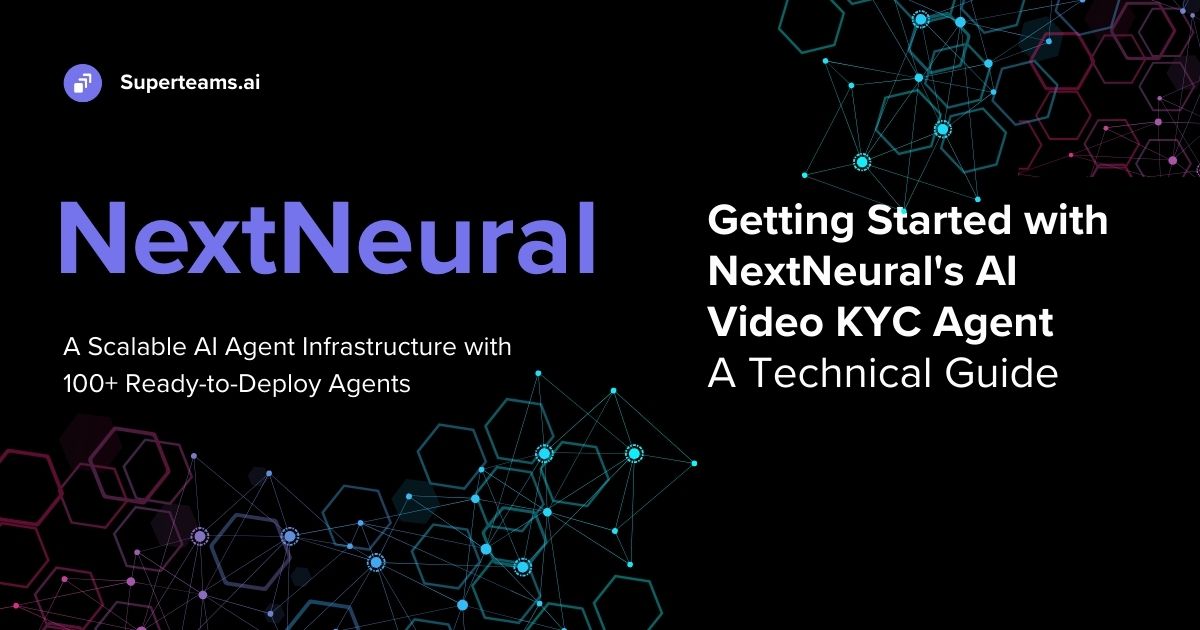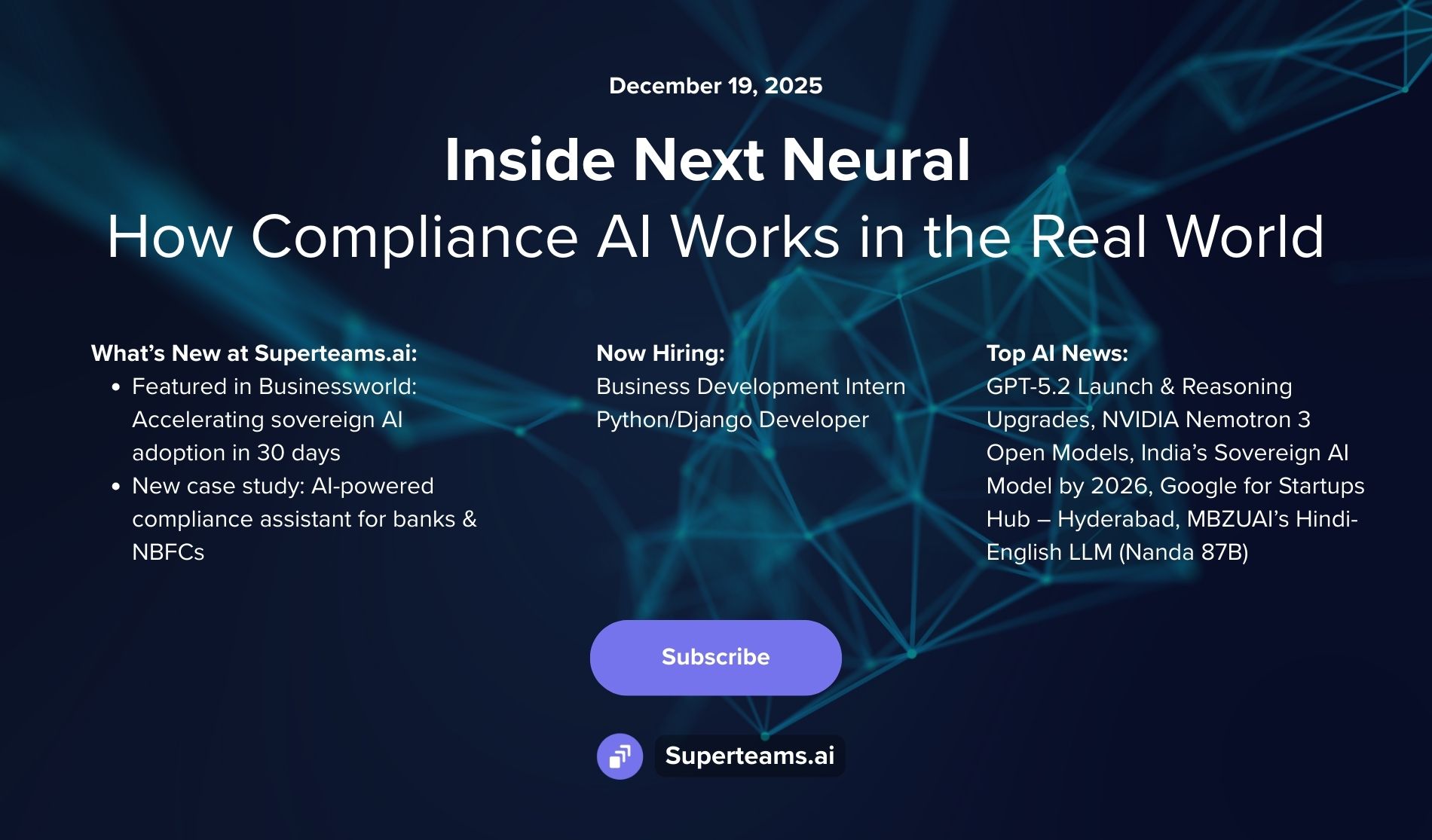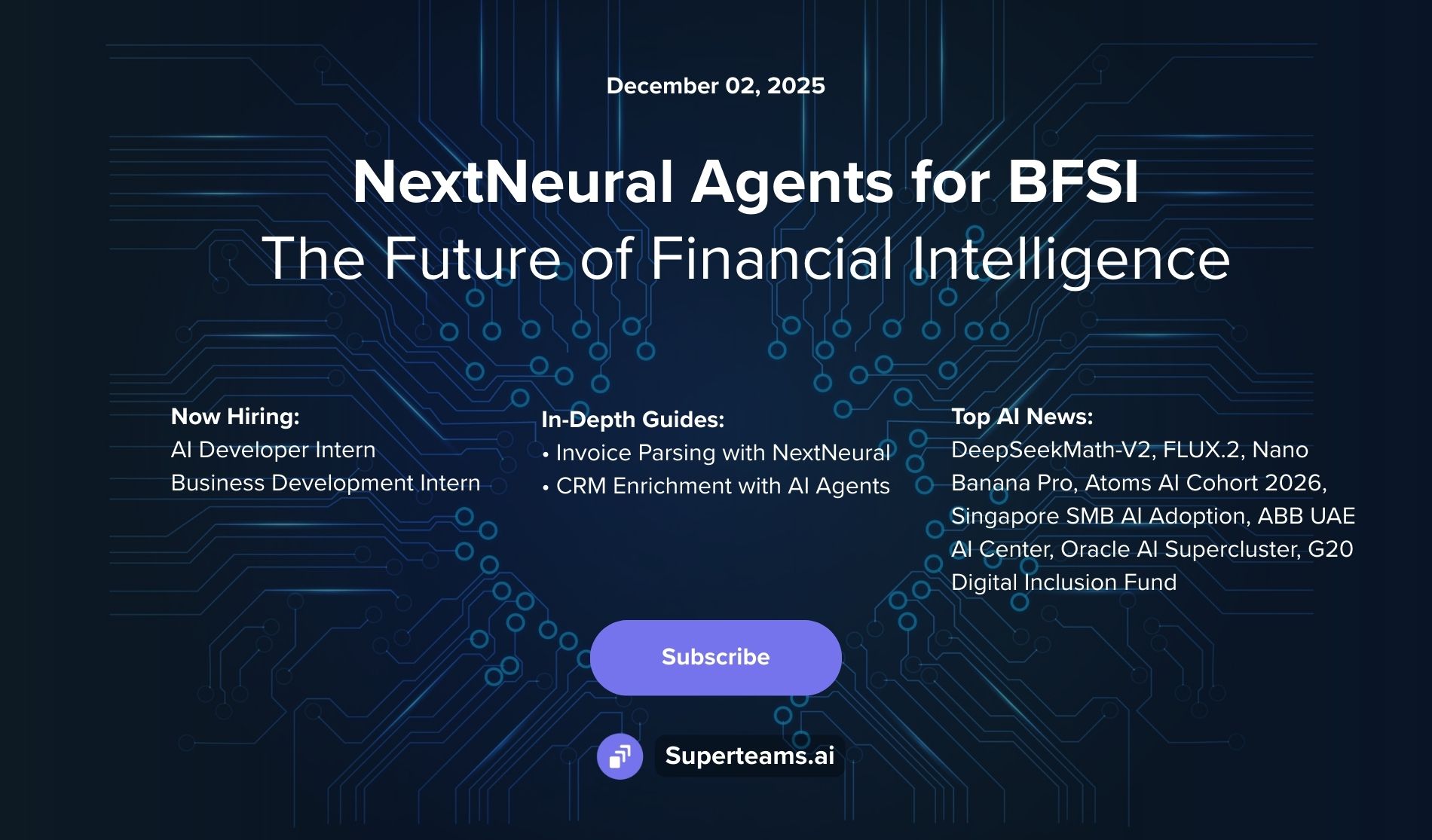How to Build Agentic AI Chatbots for Customer Support
Learn how Agentic AI can transform customer support

The rise of Large Language Models (LLMs) is reshaping UI and UX and changing how users interact with platforms. We now expect to "chat" with systems, not click endlessly to complete a task.
This shift is profoundly impacting customer support. Before ChatGPT, chatbots were rigid, following scripted decision trees with basic keyword matching, often frustrating users and failing to handle complex queries or adapt to individual needs. Today, customers expect far more: intelligent, interactive AI that understands nuance, adapts in real time, and resolves issues seamlessly. The bar is no longer basic automation; it’s AI that thinks and acts like a quasi-human.
If you don't adapt, you risk higher churn, lower satisfaction scores, and falling behind in an increasingly competitive market. Customers have low tolerance for poor experiences, and there are plenty of alternatives.
In this article, we’ll show you how to close this expectation gap by building and launching agentic AI systems on your data, giving you the edge to deliver exceptional support, lower costs, and scale intelligent customer interactions. You'll learn how to harness Anthropic’s Model Context Protocol (MCP), Google’s Agent Development Kit (ADK), vector search, and multilingual LLMs to meet customers where they are - with an AI system that’s cutting-edge and launches you into the future.
The Dual Nature of Customer Expectations
Before we dive in, let’s look at the exact problem statement: do customers always want to talk to AI when they talk to support? The answer is more nuanced than simply ‘everything AI’. While customers appreciate the efficiency of AI for routine tasks, they still value the empathy and understanding that only human agents can provide.
- Use AI to Simplify UI/UX: Many customers prefer AI-driven solutions for straightforward tasks. For instance, 51% of consumers favor interacting with bots when they desire immediate service.
- Use Human Touch for Complex Questions: Conversely, when issues are complex or emotionally charged, customers lean towards human interaction. A survey revealed that 59% of customers prefer phone calls, and 35% opt for in-person support for serious issues.
So the goal is to build systems that can efficiently handle tasks traditionally requiring manual navigation, like updating contact information or tracking orders, while ensuring that more complex, emotionally nuanced issues are directed to human agents.
To build such systems, your chatbot needs to be able to understand the user query, and route it to the right tool, or loop in a human agent. How? Let’s look at what AI agents are and systems you can use to build them.
What are AI Agents?
AI agents are autonomous software programs designed to perceive their environment, process information, and take actions to achieve specific goals without continuous human oversight. While there are many agentic patterns, they all follow the basic workflow of perceive -> reason -> act, all to achieve a goal (or set of goals).
These systems go beyond traditional LLM chatbots. They have memory, interact with tools, adapt to changes in their environment, and learn over time. Let’s unpack the technical components of an Agentic AI system.
Perception Layer
At the front of an agentic AI system is its input processing pipeline, which parses and interprets user inputs, usually in natural language.
Key Components:
- Tokenizer + Encoder: Transforms raw text into vector embeddings using a transformer-based LLM (e.g., Llama, Mistral, Claude, GPT, Gemini).
- Multimodal inputs (optional): For images, documents, or voice, an encoder like CLIP or Whisper can be used.
- Pre-processing hooks: For recognizing intents, sentiment, named entities, or parsing structured parameters (dates, IDs, etc.).
Planning & Reasoning Layer
This is where the system thinks, using tools like:
- LLMs for structured reasoning (plan → decide → act).
- Agent frameworks like:
- LangGraph / CrewAI / n8n: For stateful, multi-agent workflows.
- Google ADK: A more structured multi-agent framework allowing tool calls, sub-agents, and evaluation metrics.
- Anthropic’s MCP: Connects external data sources and tools securely with AI systems using a standard context interface.
Planning loop logic:
- Step 1: Classify the query — is it simple FAQ, account-related, or escalation-worthy?
- Step 2: Retrieve context — from internal knowledge bases, CRM systems, or ticket histories.
- Step 3: Decide on next action — reply, route, escalate, or invoke a tool.
LLMs often use function calling or tool-use APIs to trigger downstream actions.
Tool Use & Actuation Layer
Agents often use external tools to complete tasks.
Common Tools Integrated:
- CRM APIs (e.g., update address, check plan).
- Search APIs (internal & web).
- Ticketing Systems (e.g., Zendesk, Freshdesk).
- Vector Databases (e.g., Qdrant, pgvector): For semantic search across past conversations, documents, FAQs.
Agents use tool-use APIs like OpenAI’s function_calling or Claude’s tool-use protocols to select and invoke actions dynamically.
Memory Layer
To be truly agentic, the system needs long-term and short-term memory.
Technologies:
- pgvector / pgai / Qdrant: Store semantic embeddings for vector search across user histories, docs, or previous chats.
- Relational DBs (e.g., Postgres): Store structured entities like customer profiles, case histories, etc.
- Session memory (Redis / in-memory DBs): Temporary memory for the current conversation state.
Types of Memory:
- Episodic: Stores prior interactions with the user.
- Semantic: General knowledge (e.g., help center articles).
- Procedural: Steps learned from feedback ("how to escalate").
5. Interface & Output Layer
Once reasoning and actions are complete, the agent must communicate clearly.
Output Pipeline:
- Natural Language Generator: Formats structured outputs into human-friendly responses.
- Multilingual NLG: Using LLMs fine-tuned on multilingual datasets to support diverse user bases.
- Guardrails: Ensure responses are factual, on-brand, and hallucination-resistant (e.g., via RAG or retrieval-augmented generation).
Feedback Loop & Learning Layer
Agentic AI systems improve over time through:
- Active Learning Pipelines: Flagging user corrections or escalations for retraining.
- Reinforcement learning from human feedback (RLHF) or offline datasets.
- Evaluation agents (a core feature in Google ADK): Critique and refine other agents' decisions.
To build an agent, you have to put together the above layers in a way that the agent can function without constant human oversight.
AI Agents for Customer Support
At their core, AI agents for customer support are intelligent systems capable of perceiving a user query, reasoning about it, and executing the right action, whether it’s retrieving information, updating records, or escalating to a human.
Let’s break down what makes an effective customer support AI agent.
Key Capabilities of a Support-Focused AI Agent
- Should be able to understand user intent
- Uses advanced natural language understanding (NLU) to classify the customer’s request, e.g., "update address", "why was I billed?", or "cancel my subscription".
- Leverages multilingual models to support global audiences, handling grammar errors, code-switching, and typos.
- Should be able to remember conversation history
- Accesses user history: past support tickets, purchase history, user tier, or known issues.
- Combines vector search (e.g., pgvector/Qdrant) for semantic recall with structured data lookups (e.g., Postgres/CRM APIs).
- Should be able to act autonomously using tools
- Invokes APIs to perform actions like initiating refunds, booking appointments, or updating details, without manual intervention.
- Uses function-calling or tool-use APIs to trigger backend operations based on LLM planning.
- Should be able to reason
- Understands dependencies: e.g., “I never received my last order, and now you’re charging me again.”
- Resolves these with retrieval-augmented generation (RAG) that combines LLMs with real-time data.
- Should be able to escalate to human executives
- When the problem exceeds the agent’s capabilities (billing disputes, account lockouts, emotional distress), it hands off the conversation with full context—no need for the customer to repeat themselves.
- When the problem exceeds the agent’s capabilities (billing disputes, account lockouts, emotional distress), it hands off the conversation with full context—no need for the customer to repeat themselves.
- Should be able to learn over time
- Logs feedback signals from users and human agents to retrain or fine-tune behavior over time.
- Can be evaluated using tools like Google ADK’s agent evaluators or LangChain tracing.
This kind of flow, while simple on the surface, requires a tightly integrated system involving:
- A retrieval layer (for ticket and documentation search)
- A reasoning engine (the LLM)
- A tool execution layer (API calls)
- Session memory
- A fallback + escalation path to humans
If you are able to build it, you will be empowering your support operation with superhuman speed and scale. When designed right, they allow your team to focus on edge cases, while the AI handles 70–80% of repetitive interactions with precision and empathy.
Use Cases of Agentic AI in Customer Support
There are numerous ways that AI can drive up productivity in customer support. Below, we have listed the most common ones we have come across.
1. Automating Repetitive Queries
Agentic AI is highly effective at resolving routine questions like “Where’s my order?” or “How do I reset my password?” By retrieving relevant data and responding in natural language, agents can deflect a large percentage of inbound tickets.
Impact: Faster resolutions, reduced ticket volume, improved CSAT.
2. Semantic Knowledge Retrieval
Instead of keyword search, agentic agents use vector retrieval and LLMs to surface relevant content from help centers, documentation, or policy databases. This can support both users and internal agents.
Impact: Higher first-contact resolution, faster onboarding, reduced knowledge gaps.
3. Proactive Troubleshooting
Agents can identify patterns like repeated login failures or usage anomalies and reach out with suggestions or support team, even before the user submits a ticket. This proactivity can go a long way in reducing customer churn.
Impact: Reduced churn, better customer trust, lower inbound volume.
5. Multilingual & Multimodal Support
Agentic systems support multiple languages and can interpret voice or visual inputs (like error screenshots). This can enable scalable support across global audiences and platforms.
Impact: Increased accessibility, consistent quality, less reliance on translation teams.
6. Secure Support in Regulated Environments
By using protocols like Anthropic’s MCP, agents can retrieve data only from authenticated sources and generate policy-compliant answers. They can use cloud-hosted LLMs, with guardrails, so that sensitive data remains within contro. This is critical for industries like finance or healthcare.
Impact: Reduces hallucination risk, ensures compliance, enables AI use in sensitive domains.
7. Continuous Feedback & Learning
Every interaction becomes a training opportunity. Agents can log patterns, highlight edge cases, and route low-confidence responses for review, enabling continuous improvement. You can use agents to ‘watch’ human-support interactions, and flag any inconsistencies or possible improvements.
Impact: Higher model accuracy over time, better coverage, and smarter automation.
How to Build AI Agents for Customer Support
Building an AI agent that can reliably handle customer queries isn’t just about plugging an LLM into a chatbot interface. A production-grade support agent must understand context, retrieve accurate information, make decisions, call tools, and respond quickly, with minimal latency and maximum reliability.
Here’s a breakdown of the full agent architecture, from data ingestion to real-time response generation, and the critical effort required to make it robust and scalable.
1. Data Ingestion & Structuring
Before anything else, your agent needs access to the right data—clean, updated, and queryable.
- Sources: CRM records, ticketing systems, knowledge bases (PDFs, Notion docs, etc.), helpdesk logs, and policy documents.
- ETL Pipelines: Use tools like Apache Airbyte, Prefect, or custom Python scripts to sync and normalize your data.
- Metadata tagging: Add timestamps, source labels, categories, and access controls to documents for downstream filtering.
Effort tip: You’ll spend a non-trivial amount of time cleaning data and ensuring it stays updated. Invest early in this layer.
2. Vector Embedding & Storage
Once the data is ingested, it must be converted into vector embeddings to enable semantic retrieval.
- LLM Embedding Models: Use models like text-embedding-3-small, nomic-embed-text, or bge-m3 for high-quality multilingual embeddings.
- Chunking: Split documents into semantically coherent chunks. The chunking strategy matters a lot, as it will decide if the retrieved context is valuable.
- Storage: Use a vector database like Qdrant, pgai/pgvector, or Weaviate to store and index embeddings.
Effort tip: Tune your chunking strategy and embedding model—small changes here drastically impact retrieval quality.
3. LLM Query Planning & Routing
Once a user submits a query, your agent must interpret it correctly and decide what to do next.
- Intent Detection: Classify query types using zero-shot classification or fine-tuned intent models.
- Routing Logic: Based on intent, route the query to the appropriate data source, tool, or escalation path.
- LLM Prompting: Structure your prompts to include:
- System context (agent personality, restrictions)
- Retrieved knowledge
- Real-time inputs (user plan, location, etc.)
Effort tip: Build a prompt router that dynamically selects and populates the right prompt template based on intent and context.
4. Contextual Retrieval (RAG)
Use advanced Retrieval-Augmented Generation (RAG) patterns to fetch relevant documents or facts and inject them into the prompt.
- Hybrid Search: Combine vector search (semantic) with keyword filters (symbolic) for high precision.
- Scoring & Ranking: Use cosine similarity + metadata filters (e.g., user tier, geography, product line).
- Memory Access: Retrieve past user sessions or ticket history to personalize answers.
Effort tip: Avoid retrieval overload, 3–5 high-quality context chunks are more effective than 20 low-relevance ones. However, getting to those 3–5 is the tough bit.
5. Tool Use & Action Execution
For dynamic queries (e.g., "cancel my order", "what’s my plan?"), your agent must interact with external systems.
- Tool Interfaces: Build secure, callable wrappers around APIs (e.g., CRM, billing, SMS, Slack, ticketing).
- Tool Calling Protocols: Use Anthropic’s MCP, Google’s ADK, or custom code it
- Validation: Ensure API outputs are parsed and validated before presenting back to the user.
Effort tip: Keep tools atomic and testable. Avoid chaining 3–4 tool calls unless you have strong observability.
6. Response Construction
Once planning and retrieval are complete, the agent must synthesize a helpful, human-like response.
- NLG (Natural Language Generation): The LLM stitches together:
- Query understanding
- Retrieved context
- Tool outputs
- Tone & Voice: Use system prompts to match brand voice, e.g., empathetic, professional, casual.
- Fallbacks: If confidence is low or response uncertain, offer “Let me transfer you to a human.”
Effort tip: Don’t blindly trust model outputs. Add guardrails for hallucinations and link sources wherever possible.
7. Scalability & Latency Optimization
Building a smart agent is only half the game. To work at scale, it must also be fast, fault-tolerant, and low-latency.
- Caching: Cache embedding queries, frequent vector lookups, and LLM responses (using tools like Redis, Upstash, or Turso).
- Batching: Group tool calls and retrieval steps where possible to reduce roundtrips.
- Async Architecture: Use WebSockets or background workers (e.g., Celery, FastAPI background tasks) for long-running processes.
- Load Testing: Simulate concurrent sessions and test for peak load times using k6 or Locust.
Effort tip: Latency compounds. Aim for sub-1.5s total response time across all steps — LLM inference is usually your bottleneck.
8. Learning & Continuous Improvement
The best-performing systems are those that learn from real-world interactions and improve over time, based on user behavior, edge cases, and human feedback. In fact, DeepMind researchers believe that ‘experiential learning’ is the future of agentic architecture.
- Feedback Loop Integration:
- Capture implicit signals: Did the user ask again? Did they drop off?
- Capture explicit signals: thumbs up/down, CSAT scores, agent corrections.
- Annotation Pipelines:
- Send low-confidence interactions for human review.
- Use feedback to refine intent classifiers, retrain retrieval ranking models, or adjust tool usage logic.
- Model Tuning:
- Fine-tune prompts using high-quality conversations.
- Train adapters or lightweight LoRA models for domain-specific behavior.
- Auto-Evaluation:
- Use tools like Google ADK’s agent evaluators, LangSmith, or Trulens to run batch evaluations on:
- Factuality
- Helpfulness
- Policy compliance
- Escalation accuracy
- Use tools like Google ADK’s agent evaluators, LangSmith, or Trulens to run batch evaluations on:
- A/B Testing:
- Routinely compare versions of your agent (prompt variants, retrieval thresholds, tool call policies).
- Make improvements based on user behavior, not just dev intuition.
Effort tip: Learning is your competitive edge. Teams that close the loop between usage and optimization win.
There is a lot that goes into building a powerful agent. However, once you’ve kickstarted the process with a clear architecture and reliable LLM foundation, the path becomes more about iteration than invention.
Start simple: build an agent that handles a narrow, high-volume use case, like order tracking or subscription FAQs. Then gradually expand its capabilities, tool integrations, and retrieval sources. Each feedback loop makes it sharper. Over time, your agent transforms into a core part of your customer support stack, not just a chatbot, but a trusted AI system that can think, act, and grow alongside your business.
With the right stack, design, and investment in feedback loops, your agent becomes not just a support solution, but a continuously learning, self-optimizing product layer.
Let’s now look at the right approach to building AI agents.
Agentic Frameworks: Should You Use Them?
There are several powerful frameworks that have emerged that you can use to build agents. Some examples are:
- LangGraph: LangGraph is a graph-based framework built on top of LangChain. It lets you define stateful, multi-step agents where each node can represent a tool, a memory call, or a reasoning step.
- CrewAI: CrewAI is an open-source agent orchestration framework that structures agents as "roles" (think customer support agent, researcher, analyst) collaborating in a "crew" to complete a task.
- N8N: N8N is a low-code automation tool that’s starting to be used for agentic workflows, by orchestrating LLMs, APIs, databases, and logic visually.
There are many more cropping up each day - and you will discover them if you simply track LinkedIn conversations around AI.
However, while agentic frameworks have their place, we believe that if you’re serious about building reliable, production-grade AI systems, you should approach these frameworks with caution. In fact, in most cases, you’re better off avoiding heavy agentic frameworks altogether - at least in the start.
Here is why:
- Too Much Abstraction:
- At the heart of every AI agent is a bunch of LLM prompts, retrievals, and tool calls.
- When frameworks auto-generate these flows, you lose visibility into why your agent behaved a certain way.
- Poor Debuggability:
- Real-world inputs are messy: missing fields, unexpected phrasing, edge cases.
- When things go wrong, tracking the root cause through abstracted graph structures wastes time.
- Lack of Flexibility When Data Becomes Complex:
- Most agentic frameworks are optimized for clean, happy-path workflows.
- When customers’ data is messy, when APIs are unreliable, or when multiple knowledge bases must be reasoned over at once, frameworks buckle.
- Performance Penalties:
- Each layer of abstraction adds latency. The more complex your workflow, the bigger the challenge with latency.
If you want to dive-in a bit more, read Anthropic’s blog post - where they explain why you should avoid agentic frameworks.
So What Should You Do Instead?
If you're serious about building an agentic AI systems that works reliably at scale, here's a better approach:
- Own Your Core Prompt Logic
- Build and maintain clear system prompts.
- Explicitly structure your tool-use planning and decision logic inside the LLM call.
- Use Simple, Explicit Control Flows
- For multi-step tasks, orchestrate calls using FastAPI, plain Python scripts, or lightweight DAGs.
- Think in terms of state machines or decision trees that you can see and debug, not hidden flows.
- Implement Explicit Tool Wrappers
- Rather than relying on agent frameworks to abstract tools, build adapters that call your APIs, databases, or vector stores.
- Rather than relying on agent frameworks to abstract tools, build adapters that call your APIs, databases, or vector stores.
- Separate Reasoning from Execution
- Let the LLM plan actions in one step and then execute those actions deterministically.
- Let the LLM plan actions in one step and then execute those actions deterministically.
- Log Everything, Transparently
- Log raw prompts, raw tool responses, intermediate planning steps, so you can debug and retrain intelligently.
Agentic frameworks may look attractive for demos and prototypes. But at scale they introduce more problems than they solve. You should stay close to the LLM reasoning loop, own the orchestration, and build systems you can debug and evolve over time.
Google’s ADK and Anthropic’s MCP
There are two important exceptions to the general caution against agentic frameworks: Google’s Agent Development Kit (ADK) and Anthropic’s Model Context Protocol (MCP). These two are fundamentally different from typical agent orchestration libraries, and worth understanding if you’re building serious, production-grade AI systems.
Google’s Agent Development Kit (ADK)
Google’s ADK is not an agent orchestration library in the traditional sense. Instead, it’s a foundational toolkit that gives you full control over how you build agentic behavior, without hiding the core logic inside layers of abstraction.
- What it offers:
- A framework to define agents, tools, memory, and evaluators explicitly.
- Encourages clean separation between planning (reasoning) and acting (tool use).
- Integrated evaluation frameworks that help you analyze agent behavior, spot failures, and retrain systematically.
- Why it’s different:
- ADK doesn’t auto-orchestrate your flows, you design them.
- It forces you to own the plan-reason-act loop and to set up proper logging, error handling, and performance evaluation.
- It’s battle-tested for scaling up to real-world, noisy data environments.
If you want to build robust, debuggable agentic AI, ADK gives you the right primitives without hiding complexity.
Anthropic’s Model Context Protocol (MCP)
Anthropic’s MCP is also not a framework to build agents - it’s a secure, standardized way to connect LLMs to external data and tools.
- What it offers:
- A context bridge that lets you pass structured, authenticated external data into LLMs.
- Avoids forcing the model to “hallucinate” knowledge that should come from a trusted database or API.
- Ensures models know what they know, and know what they don’t.
- Why it’s different:
- It doesn’t force a specific orchestration model.
- It helps you maintain clear separation between model capabilities and external tool integrations.
- It provides security, auditing, and provenance, critical for enterprise-grade systems.
If you want your AI system to securely and reliably pull in external knowledge (e.g., past tickets, account info), MCP provides an elegant and scalable foundation. If you want to understand the basics of building agents using MCP and Google ADK, we have published tutorials on them on Superteams.ai Academy newsletter.
How Superteams.ai Helps Build Agentic AI Systems
Superteams.ai is a premium AI R&D-as-a-Service startup that helps businesses build, launch, and scale with emerging AI technologies. With the AI landscape evolving at breakneck speed, we believe the only sustainable way to deploy AI is by fostering an R&D-first mindset within your organization.
When you work with us, we operate as your extended R&D team, collaborating closely to design, develop, and deploy custom agentic AI systems tailored to your workflows, data, and goals.
Our Approach: Build → Deploy → Transfer
We follow a structured three-phase model to help organizations adopt agentic AI with confidence and speed.
1. Build (Rapid Prototyping & Use-Case Validation)
We begin by identifying a high-impact use case, usually one that’s repetitive, data-rich, and time-sensitive (e.g., customer support, internal knowledge access, lead qualification). Our team then prototypes an end-to-end agent using your real data, tightly scoped for fast feedback and early validation.
What we build:
- LLM reasoning loops (prompt design + retrieval + tool calling)
- RAG pipelines and memory layers
- Custom intent classifiers and decision routing logic
- Secure data connectors, API integrations, and observability
2. Deploy (Scalable, Production-Ready Infrastructure)
Once validated, we harden the system for production. This includes model optimizations, security layers, API rate limiting, fallback policies, and latency reduction. We deploy agents using your preferred stack (cloud or on-prem), and optionally integrate:
- Multilingual NLP capabilities
- Scalable vector stores (Qdrant, pgvector, Weaviate)
- Real-time tool execution and human fallback logic
- CI/CD pipelines for safe iteration and evaluation
3. Transfer (Capability Enablement & Internal Handoff)
Our goal isn’t to lock you in, it’s to help you build long-term internal capacity. Once the agent is live, we work with your product and engineering teams to hand over control, document everything, and even train internal stakeholders on prompt tuning, retrieval evaluation, and AI operations.
We help you:
- Train internal teams on prompt engineering and feedback loops
- Integrate agent telemetry into product and ops dashboards
- Build reusable components for future agents and workflows
Whether you're building your first LLM-powered chatbot or designing a multi-agent architecture for production systems, we help you ship faster, with a clean handoff and long-term value.
Next Steps
Agentic AI is a paradigm shift. As customer expectations rise and traditional support models strain under complexity and scale, businesses need systems that can understand, reason, act, and learn. Agentic AI systems deliver just that.
But building them isn't just about using the latest LLM, it requires thoughtful architecture, clean data, tool integrations, guardrails, and continuous learning loops. It demands an R&D mindset, fast iteration, and deep expertise across AI tooling, vector search, and human-in-the-loop design.
At Superteams.ai, we help you make that leap. Whether you're exploring your first use case or ready to scale agentic automation across your support stack, we partner with you to move from idea to deployment, with an R&D-first mindset.
Ready to build your own agentic AI system?
Let’s talk. We’ll help you identify high-leverage use cases, design a fast prototype, and set up a roadmap that fits your infrastructure and business goals.
👉 Book a Strategy Call or Contact Us to get started.


